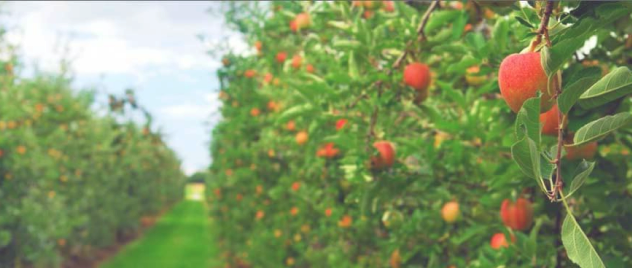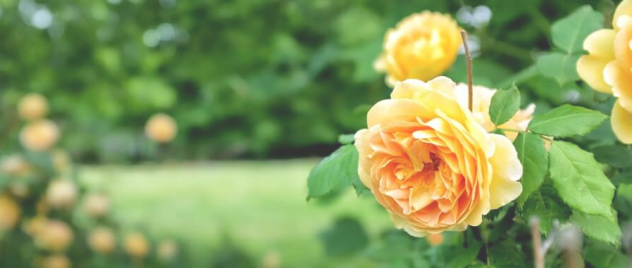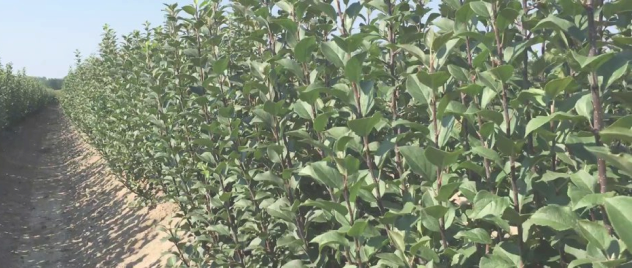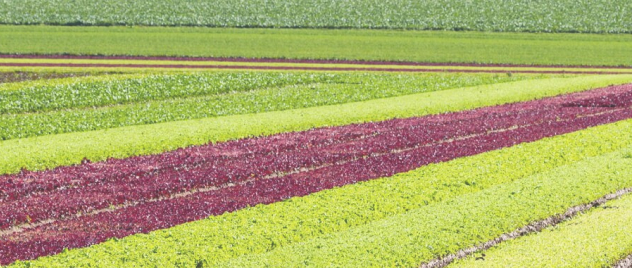QUINCES
Quince (Cydonia oblonga L.), a unique deciduous fruit tree from the Rosaceae family, is a sole member of the Cydonia genus, boasting a 4000-year history originating in the Caucasus. Resembling a blend of apples and pears in shape, the golden-yellow quince is renowned for its role in various culinary creations. It is a kitchen staple for making jams, compotes, jellies, and the famous quince brandy. Loaded with vitamin C, minerals like sodium, potassium, and essential nutrients, quince is not just versatile but also nutritious. Whether for professional orchards or enthusiastic hobbyists, our nurseries offer top-quality quince fruit trees, continuing this rich tradition.
QUINCE
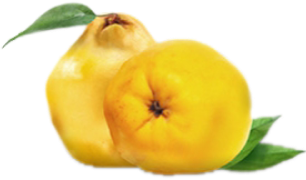
ROOTSTOCKS
BA 29
This is a quince rootstock that is used in pear production when short wide fruit is desired. A semi-intensive, low vigor planting rootstock. Early bearing, very high-yielding. Tolerant of heavy and wet soil, as well as a root-lesion nematode. Fair anchorage system. Drought tolerant.
TRAINING SYSTEMS
CENTRAL LEADER SYSTEM
In this traditional system, the quince tree features a single dominant central leader trunk with lateral branches spreading out at regular intervals. The central leader is encouraged to grow vertically, which helps create a balanced and structured canopy. This system promotes good air circulation, making it less susceptible to diseases. Pruning is essential to maintain the central leader's dominance and to shape the tree.
OPEN CENTER SYSTEM
The open center, or vase-shaped system, is another popular choice for quince trees. It involves removing the central leader to encourage multiple scaffold branches to radiate outwards. This open structure allows sunlight to penetrate the canopy, promoting even fruit ripening and reducing disease pressure. Proper pruning is vital to maintain the open center shape and to remove overcrowded or crossing branches.
HIGH-DENSITY PLANTING
This modern approach involves planting multiple quince trees in a confined space and training them to form a compact, high-yield canopy. High-density planting maximizes space utilization and simplifies maintenance, as it's usually compatible with efficient mechanized practices. Pruning and thinning are carefully managed to ensure that the quince trees remain productive and healthy.
See our full SELECTION of QUINCE TREES we have in our offer
LESKOVAC
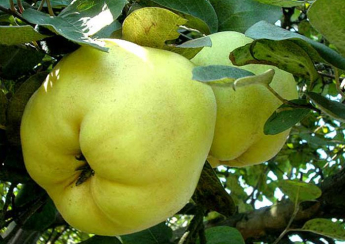
TREE:
The Leskovac quince, a distinguished member of the Cydonia oblonga family, is a deciduous treasure known for its resilience and distinctive fruit. Hailing from Serbia, this variety boasts a robust and spreading growth habit with a well-shaped canopy, making it a sought-after choice among orchard growers. In early spring, typically in April, it graces the landscape with delicate white and pink blossoms, promising a bountiful harvest.
POLLINATORS:
Vranjska quince is the pollenizer of this variety.
FRUIT APPEARANCE:
Leskovac quinces are celebrated for their eye-catching appearance. These golden-yellow to greenish-yellow fruits exhibit a slightly irregular, pear-like shape with a distinct neck. Their smooth skin hints at the tender, aromatic flesh within, making them a versatile choice for both culinary and ornamental purposes. With a unique balance of sweetness and tartness, they delight the taste buds and infuse dishes with their distinctive flavor.
FRUIT SIZE: Leskovac quinces are of medium size to very large, 200-500 grams in weight, offering an ideal combination of fruit yield and tree manageability, suitable for a wide range of applications.
HARVEST:
Leskovac quinces typically ripen in the late autumn, usually from October to November, depending on the local climate. Optimal picking time is when their skin transforms into a rich golden-yellow hue and they yield gently to pressure.
COMMERCIAL USE:
Leskovac quinces hold a special place in the culinary world for their delightful taste and aromatic qualities. They are frequently used in making jams, preserves, and jellies, and they are also prized for creating quince paste and quince brandy. Their unique ability to withstand cooking without sacrificing their flavor and aroma makes them versatile for both sweet and savory dishes, contributing to their popularity in traditional Balkan and Mediterranean recipes. Whether you're a professional orchardist or a passionate home gardener, Leskovac quinces are a cherished addition to any fruit collection.
VRANJSKA
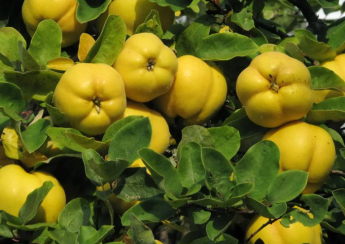
TREE:
The Vranjska quince tree, a member of the Cydonia oblonga family, is a deciduous beauty, known for its resilience and distinctive fruit. This variety, hailing from Serbia, boasts a robust and spreading growth habit with a well-shaped canopy, making it a popular choice among orchard growers. Blooming in early spring, typically in April, it offers a delightful burst of white and pink flowers before the fruit sets.
POLLINATORS:
Self-fertile, and a pollenizer to Leskovac variety.
FRUIT APPEARANCE:
Vranjska quinces are renowned for their striking appearance. These golden-yellow to greenish-yellow fruits take on a slightly irregular, pear-like shape with a distinct neck. Their smooth skin hints at the tender flesh within, making them ideal for both culinary and ornamental purposes. Their unique aroma and flavor profile, sweet with a hint of tartness, are a delight for the senses.
FRUIT SIZE: Vranjska quinces are very large, 500-600 grams in weight, offering a balanced combination of fruit yield and tree size, making them manageable and suitable for various applications.
HARVEST:
Vranjska quinces are typically ready for harvest in the late autumn, usually from October to November, depending on local climate conditions. They should be picked when their color turns a rich golden-yellow and they yield slightly to gentle pressure, indicating ripeness.
COMMERCIAL USE:
Vranjska quinces are highly valued in the culinary world for their delightful taste and aromatic qualities. Often used in making jams, preserves, and jellies, they are also a favorite for creating quince paste and quince brandy. Their ability to withstand cooking without losing their flavor and aroma makes them versatile for both sweet and savory dishes, contributing to their popularity in various traditional Balkan and Mediterranean recipes. Whether you're a professional orchardist or a passionate home gardener, Vranjska quinces are a prized addition to your fruit collection.
CHAMPION
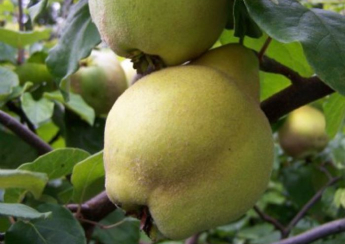
TREE:
The Champion quince, a distinguished member of the Cydonia oblonga family of American heritage, stands as a testament to both its hardiness and versatility. A deciduous treasure, this quince variety is celebrated for its vigorous growth habit and well-structured canopy, making it an excellent choice for orchard cultivation. Spring ushers in a stunning display of pink and white blossoms, signaling the promise of a prolific harvest.
FRUIT APPEARANCE:
Champion quinces are prized for their striking appearance. These fruits are typically greenish-yellow to golden-yellow, boasting an elegant pear-like form with a well-defined neck. The smooth skin offers a tantalizing glimpse of the aromatic, tender flesh within. Known for their balanced sweetness and tartness, Champion quinces are a culinary treasure that adds a unique flavor to a wide array of dishes and preserves.
FRUIT SIZE: Champion quinces typically exhibit a medium to large size, 360-450 grams each, ensuring a satisfying fruit yield while remaining manageable for both orchard maintenance and home cultivation.
HARVEST:
The optimal time for harvesting Champion quinces usually arrives in late autumn, around October to November, contingent upon the local climate. An ideal quince is identified by its transformation to a radiant golden-yellow hue and its slight yielding to gentle pressure.
COMMERCIAL USE:
Champion quinces are highly regarded in the culinary realm for their superb flavor and aromatic qualities. They are often employed in the creation of mouthwatering jams, preserves, jellies, and quince paste. These quinces also shine as a choice ingredient for delectable pies, tarts, and other sweet treats. Their versatility in the kitchen, which allows them to withstand cooking while retaining their distinctive flavor and aroma, has made them a staple in a variety of traditional and contemporary recipes. Whether you're a seasoned orchardist or an enthusiastic home gardener, Champion quinces are a valuable addition to any fruit collection.

